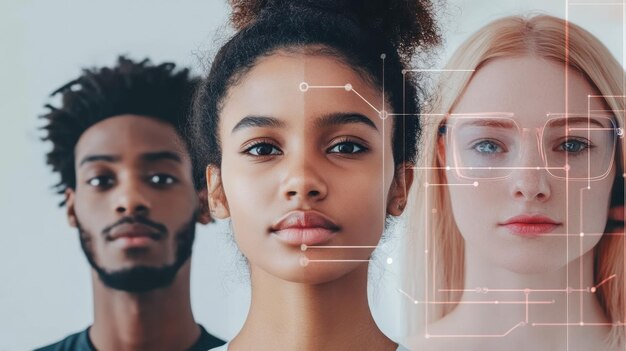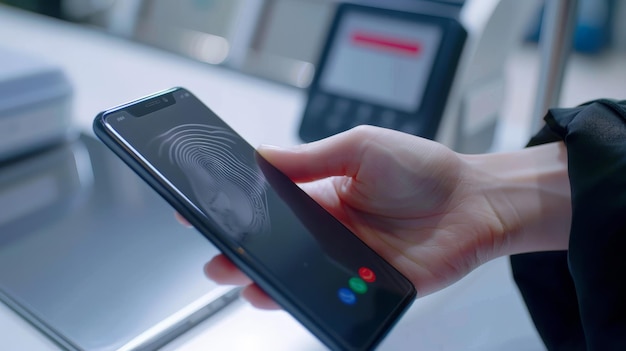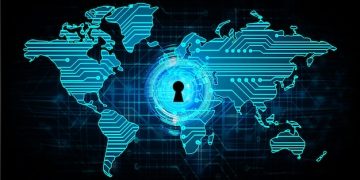Biometrics in the US: A New Era of Security and Convenience

The Rise of Biometrics: Enhancing Security and Convenience in the US is transforming industries by offering more secure and user-friendly authentication methods, from unlocking smartphones to streamlining airport security, raising important questions about privacy and data security.
The world is rapidly embracing biometric technology, and the United States is at the forefront of this revolution. The Rise of Biometrics: Enhancing Security and Convenience in the US is changing how we interact with our devices, access buildings, and even travel. But what exactly are biometrics, and how will they affect your life?
Understanding the Basics of Biometrics
Biometrics involve identifying individuals based on their unique biological traits. These traits are measurable physiological or behavioral characteristics that can be used to verify or recognize identity. From fingerprint scanners to facial recognition software, biometrics are becoming increasingly prevalent in various sectors.
Biometric systems typically operate through several stages, including capturing biometric data, extracting unique features, and comparing this data against stored templates. This automated process facilitates quick and reliable authentication, minimizing the need for traditional methods like passwords or PINs.
Common Types of Biometric Identifiers
Several types of biometric identifiers are in use, each with its own strengths and applications. Understanding these different methods is vital for grasping the breadth of biometric technology.
- Fingerprint Recognition: One of the oldest and most widely used biometric methods, fingerprint recognition involves scanning and analyzing the unique patterns of ridges and valleys on a person’s fingertips.
- Facial Recognition: This technology uses algorithms to map and analyze facial features from an image or video. It is commonly used in security systems, smartphone unlocking, and social media tagging.
- Iris Scanning: Iris scanning captures and analyzes the intricate patterns of the iris, the colored part of the eye. It’s known for its high accuracy and is often used in high-security environments.
- Voice Recognition: Voice recognition identifies individuals based on their unique voice patterns. This technology is used in voice assistants, phone authentication, and security systems.
As technology advances, new forms of biometrics are constantly being developed and refined. This evolution aims to improve accuracy, security, and user convenience.
In conclusion, biometrics provide a more secure and convenient alternative to traditional authentication methods. By understanding the different types of biometric identifiers and how they work, we can better appreciate their potential impact on various aspects of our lives.
The Growing Adoption of Biometrics in the US
The United States has witnessed a significant surge in the adoption of biometrics across various industries, fueled by the need for enhanced security and seamless user experiences. From government agencies to private businesses, the benefits of biometric authentication are becoming increasingly apparent.
This rising trend is driven by the increasing sophistication of cyber threats and the desire to mitigate fraud. Biometrics offer a more robust defense against unauthorized access compared to traditional methods.

Biometrics in Government and Public Safety
Government agencies are leveraging biometrics to enhance security and streamline operations. Public safety organizations are also utilizing these technologies to improve law enforcement and emergency response.
- Border Security: U.S. Customs and Border Protection (CBP) uses facial recognition technology to verify the identities of travelers entering and exiting the country, improving security and expediting the screening process.
- Law Enforcement: Law enforcement agencies employ biometric tools such as fingerprint and facial recognition to identify suspects, solve crimes, and enhance public safety.
- National Security: Federal agencies utilize biometrics for background checks, access control, and threat detection, safeguarding national security interests.
These applications show the government’s commitment to enhancing security measures through biometric technology.
Biometrics in the Private Sector
The private sector is increasingly adopting biometrics to improve customer experiences and enhance security. These applications span various industries, from finance to healthcare.
- Banking and Finance: Banks are using biometric authentication for mobile banking apps, ATM access, and fraud prevention.
- Healthcare: Healthcare providers are implementing biometric systems to verify patient identities, secure medical records, and streamline access to facilities.
- Retail: Retailers are using facial recognition technology to personalize customer experiences, prevent theft, and manage loyalty programs.

In summary, the growing adoption of biometrics in the US reflects a broader trend toward enhanced security and convenience. Both government and private organizations are recognizing the benefits of these technologies and implementing them in various applications.
Benefits of Biometrics: Security and Convenience
Biometrics offer a range of benefits that contribute to enhanced security and greater convenience. These advantages are driving their increasing adoption across diverse sectors.
The core advantages of biometrics stem from their ability to provide more reliable and efficient authentication methods compared to traditional passwords and PINs.
Enhanced Security Measures
One of the primary benefits of biometrics is their ability to enhance security. Unlike passwords or PINs, biometric identifiers are difficult to forge or steal.
Biometrics offer several advantages over traditional security measures:
- Resistance to Hacking: Biometric data is encrypted and stored securely, making it difficult for hackers to compromise.
- Prevention of Identity Theft: Biometric authentication reduces the risk of identity theft by verifying individuals based on their unique biological traits.
- Reduced Fraud: Biometrics help prevent fraudulent activities by ensuring that only authorized individuals can access sensitive information or resources.
These factors make biometrics a robust defense against various security threats.
Improved User Convenience
In addition to security, biometrics offer significant convenience for users. They eliminate the need to remember multiple passwords or carry physical access cards.
Biometric authentication contributes to greater user convenience by:
- Streamlining Access: Biometrics enable quick and seamless access to devices, buildings, and systems, reducing delays and improving efficiency.
- Eliminating Forgotten Passwords: Biometric identifiers eliminate the frustration of forgotten passwords or PINs, simplifying the authentication process.
- Enhancing User Experience: Biometric authentication provides a more user-friendly and intuitive experience, making it easier for individuals to interact with technology.
In conclusion, biometrics offer a compelling combination of enhanced security and improved user convenience. These benefits are driving their increasing adoption across various industries and applications. By leveraging unique biological traits, biometrics provide a more reliable and efficient means of authentication.
Privacy Concerns and Ethical Considerations
While biometrics offer numerous benefits, they also raise significant privacy concerns and ethical considerations. Addressing these issues is essential for ensuring the responsible and ethical adoption of biometric technology.
The collection, storage, and use of biometric data can pose potential risks to individual privacy and civil liberties. It is crucial to implement safeguards that protect against misuse and unauthorized access.
Data Security and Storage
One of the primary privacy concerns surrounding biometrics is the security and storage of biometric data. If this data is compromised, it could lead to identity theft and other forms of abuse.
Key considerations include:
- Encryption: Biometric data must be encrypted both in transit and at rest to prevent unauthorized access.
- Secure Storage: Biometric data should be stored in secure facilities with strict access controls.
- Regular Audits: Regular audits should be conducted to ensure that biometric systems are secure and compliant with privacy regulations.
Furthermore, transparency is crucial to building trust with users.
Potential for Misuse and Abuse
Another ethical consideration is the potential for misuse and abuse of biometric technology. This includes using biometrics for surveillance, discrimination, or other unethical purposes.
To mitigate these risks, it is important to:
- Establish Clear Policies: Organizations should establish clear policies and guidelines for the collection, use, and sharing of biometric data.
- Obtain Informed Consent: Individuals should be informed about how their biometric data will be used and provide their explicit consent.
- Provide Oversight: Independent oversight bodies should be established to monitor the use of biometric technology and ensure compliance with privacy regulations.
By addressing these privacy concerns and ethical considerations, we can promote the responsible and ethical use of biometric technology.
Future Trends in Biometric Technology
The field of biometrics is continually evolving, with new technologies and applications emerging regularly. Several key trends are shaping the future of biometric technology.
These trends include advances in accuracy, integration with other technologies, and expansion into new industries. Understanding these trends can help us anticipate the future impact of biometrics on society.
Advancements in Accuracy and Reliability
One of the primary areas of focus is improving the accuracy and reliability of biometric systems. This involves developing more advanced algorithms and sensors that can capture and analyze biometric data with greater precision.
Innovations include:
- Improved Algorithms: Machine learning and artificial intelligence are being used to develop more sophisticated algorithms that can accurately identify individuals in challenging conditions.
- Advanced Sensors: New sensors are being developed to capture higher-resolution biometric data, improving the accuracy of identification.
- Multi-Factor Authentication: Combining multiple biometric identifiers, such as fingerprint and facial recognition, can further enhance accuracy and security.
These advancements will lead to more reliable and secure biometric systems.
Integration with Emerging Technologies
Biometrics are increasingly being integrated with other emerging technologies, such as artificial intelligence, blockchain, and the Internet of Things (IoT). This integration is creating new opportunities for innovation and efficiency.
Examples of integration include:
- AI-Powered Biometrics: AI is being used to enhance biometric systems by improving accuracy, detecting fraud, and personalizing user experiences.
- Blockchain-Based Identity: Blockchain technology is being used to create decentralized identity systems that allow individuals to control their own biometric data.
- Biometrics in IoT Devices: Biometrics are being integrated into IoT devices, such as smart home devices and wearable technology, to provide secure and convenient authentication.
Expansion into New Industries
Biometrics are expanding into new industries and applications, driven by the need for enhanced security and efficiency.
Emerging applications include:
- Education: Schools and universities are using biometrics for attendance tracking, access control, and exam proctoring.
- Hospitality: Hotels and resorts are using biometrics for guest check-in, room access, and personalized services.
- Transportation: Airlines and airports are using biometrics for passenger identification, security screening, and boarding processes.
In conclusion, the future of biometric technology is bright, with ongoing advancements in accuracy, integration with emerging technologies, and expansion into new industries. These trends will continue to shape the way we interact with technology and enhance security in various aspects of our lives.
Navigating the Future with Biometrics: A Balanced Approach
As biometrics become increasingly integrated into various aspects of our daily lives, adopting a balanced approach is crucial. This involves maximizing the benefits of biometrics while mitigating potential risks and addressing ethical concerns.
A balanced approach requires collaboration among policymakers, technology developers, and the public to establish clear guidelines and regulations that govern the use of biometric technology.
To achieve this balanced approach, it’s essential to consider the following points:
Establish Clear Legal Frameworks: Governments and regulatory bodies must establish clear legal frameworks that govern the collection, storage, and use of biometric data. These frameworks should address privacy concerns, data security, and potential for misuse.
Promote Transparency and Accountability: Organizations that use biometric technology should be transparent about how they collect, use, and share biometric data. They should also be accountable for ensuring the security and privacy of this data.
Engage in Public Dialogue: Foster public dialogue about the ethical considerations surrounding biometric technology. This dialogue should involve stakeholders from various sectors, including policymakers, technology developers, privacy advocates, and the general public.
Embrace Continuous Improvement: Biometric technology is constantly evolving, so it is essential to embrace continuous improvement in terms of accuracy, security, and ethical considerations. Organizations should stay informed about the latest advancements and adjust their practices accordingly.
By adopting a balanced approach, we can harness the power of biometrics to enhance security, improve convenience, and drive innovation while safeguarding individual privacy and civil liberties. This involves establishing clear guidelines, promoting transparency, engaging in public dialogue, and embracing continuous improvement.
| Key Point | Brief Description |
|---|---|
| 🔑 Enhanced Security | Biometrics offer more secure authentication compared to passwords. |
| 🚀 Convenience | Biometrics streamline access and eliminate forgotten passwords. |
| 🛡️ Privacy Concerns | Data security and potential misuse are significant concerns. |
| 🔮 Future Trends | Advancements in accuracy and integration with AI are emerging. |
Frequently Asked Questions (FAQ)
▼
The main types include fingerprint recognition, facial recognition, iris scanning, and voice recognition. Each uses unique biological or behavioral traits for identification and verification.
▼
Biometric data storage security depends on encryption, secure storage facilities, and regular audits. These measures protect against unauthorized access and data breaches.
▼
Biometrics offer enhanced security by being difficult to forge or steal. They also provide improved user convenience by eliminating the need to remember multiple passwords.
▼
Industries using biometrics include government, finance, healthcare, retail, education, hospitality, and transportation, each for various applications like security and convenience.
▼
Ethical considerations include the potential for misuse, data security risks, and the need for transparency and informed consent regarding the collection and use of biometric data.
Conclusion
The Rise of Biometrics: Enhancing Security and Convenience in the US is undeniable, promising increased security and streamlined user experiences. However, it is crucial to address the ethical considerations and privacy concerns that come with this technology. By establishing clear guidelines, promoting transparency, and engaging in informed public discourse, we can navigate the future of biometrics responsibly and ensure that its benefits are realized while safeguarding individual rights.





